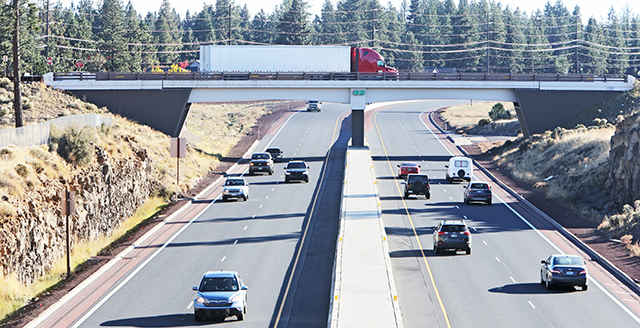
A truck driver crosses over U.S. Hwy 97 the interchange with 3rd Street south of Murphy Road in Bend. 10/15/25 (Dean Guernsey/The Bulletin)
The Bend City Council has allocated $18 million in taxpayer bond funding to address traffic congestion on Empire Avenue, significantly impacting several planned projects. This decision, made last week, prioritizes improvements on a critical east-west corridor while leaving four other projects without necessary support, including vital highway ramps at Murphy Crossing.
The funding consolidation comes amid ongoing challenges regarding state funding and escalating construction costs. As the city aims to optimize the $190 million general obligation bond approved by Bend voters in 2020, local officials are grappling with the implications of a recent state legislative bill that blocked new construction funding. Instead, it focused on maintaining existing infrastructure, preventing potential layoffs at the Oregon Department of Transportation (ODOT).
City officials are actively evaluating options to alleviate congestion on Empire Avenue. Potential solutions range from upgrading traffic signals to adding turn lanes or even constructing a new highway connection. As congestion worsens, particularly due to increased housing developments in northeast Bend, the urgency for action has mounted.
Omar Ahmed, area manager with ODOT, noted, “Our funding never materialized over the last five years,” highlighting the financial constraints affecting local transportation projects. The city had initially earmarked funds for multiple projects, including a planned $3 million frontage road at the Butler Market Road exit and a $430,000 signal or roundabout near Colorado Avenue.
Now, with a shift in funding priorities, the Powers Road intersection project faces a $2.6 million setback. This intersection, hosting the last traffic signal on the parkway, is crucial for improving traffic flow. Additionally, the previously anticipated improvements at Murphy Road will remain incomplete, lacking northbound and southbound ramps essential for traffic efficiency.
The city had allocated $10 million in bond funds to finalize these ramps, yet ODOT estimates the overall project costs to be between $20 million and $25 million. Ryan Oster, Bend’s City Engineer, expressed the constraints faced by ODOT, stating, “We’re just not in a world right now where ODOT has 10 to 15 million dollars to throw at the Murphy Crossing.”
Despite the setbacks, the Oregon Department of Transportation still holds $5.5 million specifically for Empire Avenue improvements. This funding may enable a short-term solution, such as adding a right turn lane to facilitate westbound traffic to Highway 20 and modernizing outdated traffic signals to alleviate car queues.
Before the recent funding decisions, the city had already set aside $1.4 million for an ODOT project aimed at widening Empire Avenue to five lanes. Ahmed indicated that other intermediate projects could be pursued as funding becomes available, reinforcing the need for immediate action on congestion issues.
Long-term solutions, such as a direct connection from Highway 20 to the parkway, have been discussed for decades but remain under consideration due to cost and complexity. Councilor Ariel Méndez expressed caution, arguing against prioritizing new freeway connections. He advocates for alternative methods to reduce congestion, such as promoting cycling and public transportation.
As the city continues to navigate funding challenges, it has spent roughly one-third of the bond funds on various road projects aimed at enhancing traffic flow and safety. In a recent development, the city was awarded a $32 million federal grant for a long-awaited railroad overcrossing on Reed Market Road. This funding should enable the city to redirect approximately $20 million in bond funds to cover cost overruns on other initiatives.
Oster remains optimistic about the federal grant’s stability, stating, “We’re planning on the funding coming through.” Nonetheless, the ongoing fluctuations in transportation funding underscore the complexities facing local governments as they strive to meet growing infrastructure demands.






